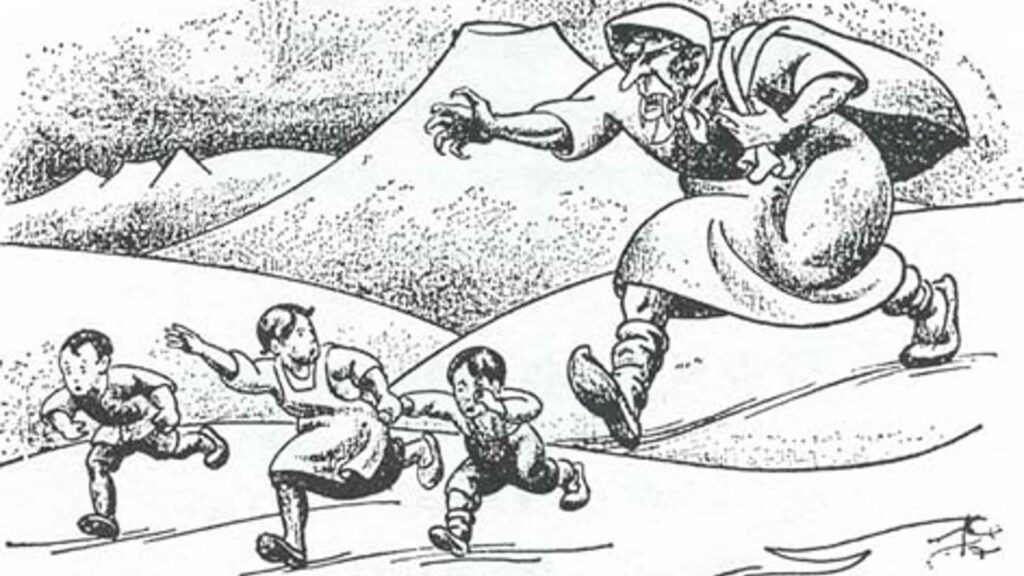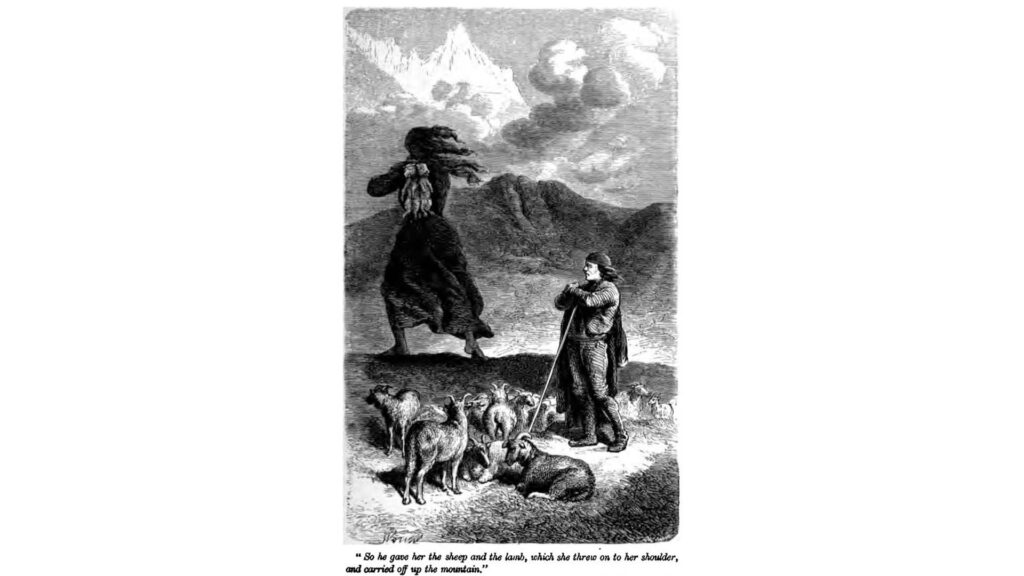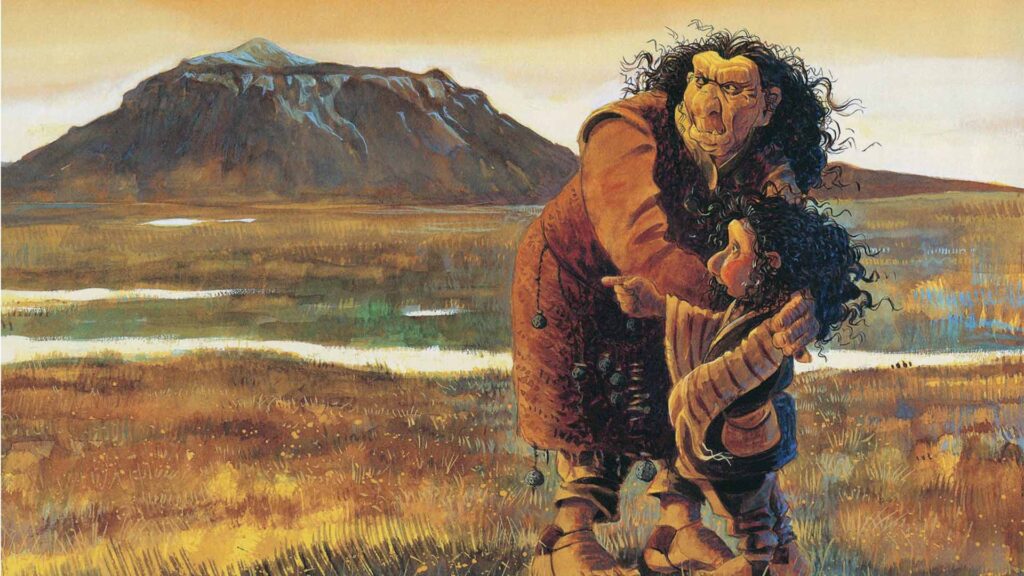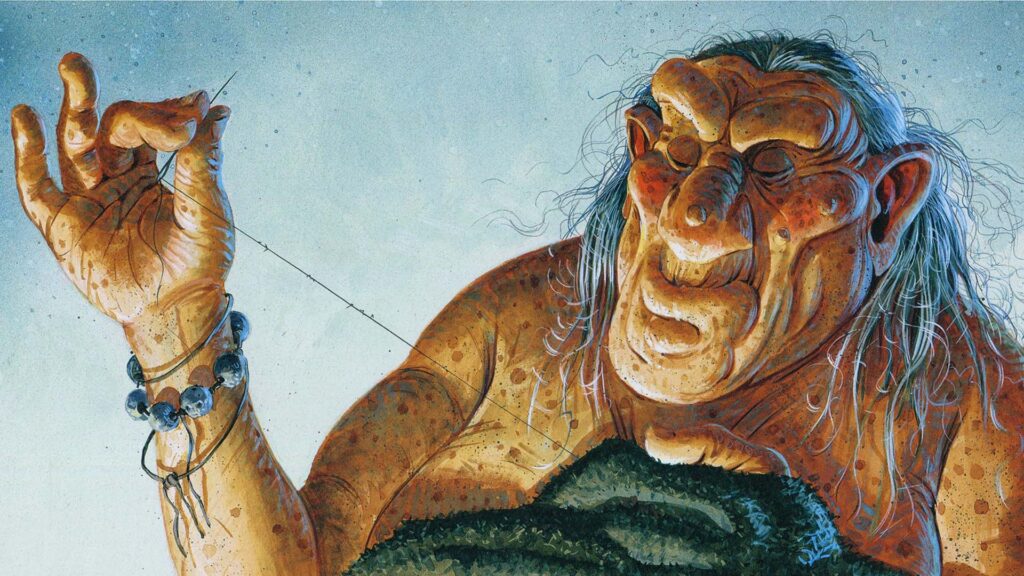Trolls in Icelandic folktales are common and many Icelanders will tell you that you can see their stony outlines in many hills and mountains. But as you might know, trolls turn into stone when hit by sunlight.
Our famous Yule-lads and their parents Grýla and Leppalúði are trolls, who do not turn to stone when daylight hits but they still do their deeds at night. You can read about the family here and their house pet, the Christmas Cat.

Even if trolls are often stupid and evil in the folktales, some are clever and even if they seem mean-spirited are kind underneath. Well, as long as the person the story is about foils their plans. That is the case of the troll in the tales of the Shepherd of Silfrúnarstaðir.
Read other legends and fairytales:
- Sæmundur the Learned and the Devil
- The Genesis of the Hidden People
- The Deacon of Myrká
- The Tale of Búkolla – Version 1 and 2
- White Cap
- Dear Mother in the Pen, Pen
- The Story of Mjaðveig Mánadóttir
- The Bishop and The Elves
- Katla’s Dream
- Now I should laugh if I were not dead!
- The Story of Bergþór of Bláfell
- The Merman
- Móhúsa-Skotta
- “The Darkness is Fun”
- The Sorcerers in The Westman Islands
- The Two Sigurds
- The Merman
- The Manservant and the Water-Elves
- Gold Brow
- Úlfsvatn
The Shepherd of Silfrúnarstaðir
A man named Guðmundur lived once upon a time at a farm called Silfrúnarstaðir in the bay of Skagafjörður. He was rich in flocks and looked upon by his neighbors as a man of high esteem and respectability. He was married but had no children.
One Christmas eve, at Silfrúnarstaðir, the herdsman did not return home at night. As he was not found at the sheep pens, the farmer caused a diligent search to be made for him all over the country, but quite in vain.
Next spring Guðmundur hired another shepherd, named Grímur, who was tall and strong and boasted of being able to resist anybody. But the farmer, despite the man’s boldness and strength, warned him to be careful how he ran risks and, on Christmas eve, bade him drive the sheep early into the pens and come home to the farm while it was still daylight. But in the evening, Grímur did not come back. Even though he was searched for far and near, he was never found. People made all sorts of guesses about the cause of his disappearance. But the farmer was full of grief and could not get anyone to act as a shepherd for him after this.
At this time, a very poor widow lived at Sjávarborg who had several children, of whom the eldest, aged fourteen years, was named Sigurður.
To this woman, the farmer, at last, applied and offered her a large sum of money if she would allow her son to act as a shepherd for him. Sigurður was very anxious that his mother should have all this money. He declared himself most willing to undertake the office. So, he went with the farmer, and during the summer, he was most successful in his new situation and never lost a sheep.
At the end of a certain time, the farmer gave Sigurður a wether, a ewe, and a lamb as a present, with which the youth was much pleased.
First Christmas eve
Guðmundur became attached to him and, on Christmas eve, begged him to come home from his sheep before sunset.
The boy watched the sheep all day long, and when evening approached, he heard heavy footsteps on the mountains. Turning around, he saw coming towards him a gigantic and terrible troll.
She addressed him, saying, “Good evening, my Sigurður. I am come to put you into my bag.”
Sigurður answered, “Are you cracked? Do you not see how thin I am? Surely, I am not worth your notice. But I have a sheep and a fat lamb here which I will give you for your pot this evening.”

So, he gave her the sheep and the lamb, which she threw onto her shoulder, and carried off up the mountain again. Then Sigurður went home, and right glad was the farmer to see him safe. Asked him whether he had seen anything.
“Nothing whatever, out of the common,” replied the boy.
After New Year’s Day, the farmer visited the flock. Looking over them, missed the sheep and lamb he had given the youth and asked him what had become of them. The boy answered that a fox had killed the lamb and that the wether had fallen into a bog. Adding, “I fancy I shall not be fortunate with my sheep.”
When he heard this, the farmer gave him one ewe and two wethers and asked him to remain another year in his service. Sigurður consented to do so.
Second Christmas eve
Next Christmas eve, Guðmundur begged Sigurður to be cautious, and not run any risks, for he loved him as his own son.
But the boy answered, “You need not fear; there are no risks to run.”
When he had got the sheep into the pens about nightfall, the same troll came to him and said :
“As sure as ever I am a troll, you shall not, this evening, escape being boiled in my pot.”
“I am quite at your service,” answered Sigurður, intrepidly, “but you see that I am still skinny; nothing to be compared even to one wether. I will give you, however, for your Christmas dinner, two old and two young sheep. Will you condescend to be satisfied with this offer of mine?”
“Let me see,” said the troll. The lad showed her the sheep. She hooked them together by their horns, threw them onto her shoulder and ran off with them up the mountain. Then Sigurður returned to the farm. When questioned, declared, as before, that he had seen nothing whatever unusual upon the mountain.

“But,” he said, “I have been dreadfully unlucky with my sheep, as I said I should be.”
Next summer, the farmer gave him four more wethers.
Third Christmas eve
When Christmas eve had come again, just as Sigurður was putting the sheep into their pens, the troll came to him and threatened to take him away with her. He offered her the four wethers, which she took. Hooked them together by their horns, and threw them over her shoulder. Not content with this, she seized the lad. Tucked him under her arm, and ran off with her burthen to her cave in the mountains.
Here she flung the sheep down, Sigurður after them, and ordered him to kill them and shave their skins.
When he had done so, he asked her what task she had now for him to perform.
She said, “Sharpen this ax well, for I intend to cut off your head with it.”
When he had sharpened it well, he restored it to the troll. She bade him take off his neckerchief, which he did, without changing a feature of his face.
Then the troll, instead of cutting off his head, flung the ax down on the ground and said, “Brave lad! I never intended to kill you; you shall live to a good old age. I caused you to be made herdsman to Guðmundur, for I wished to meet with you. And now I will show you how you shall arrive at good fortune. Next spring, you must move from Silfrúnarstaðir and go to the house of a silversmith to learn his trade. When you have learned it thoroughly, you shall take some specimens of silverwork to the farm where the dean’s three daughters live.
I can tell you that the youngest of them is the most promising maiden in the whole country; her elder sisters love dresses and ornaments and will admire what you bring them. Still, Margaret will not care about such things. When you leave the house, you shall ask her to accompany you as far as the door. Then as far as the end of the field, which she will consent to do. Then you shall give her these three precious things — this handkerchief, this belt, and this ring; after that, she will love you. But when you have seen me in a dream, you must come here, and you will find me dead. Bury me and take for yourself everything of value that you find in my cave.”
Then Sigurður bade her farewell, left her, and returned to the farm. Guðmundur welcomed him with joy, having grieved at his long absence, and asked him whether he had seen nothing.
“No,” replied the boy and declared that he could answer for the safety of all future herdsmen. But no more questions would he answer, though the family asked him many.

The following spring, he went to a silversmith’s house and made himself master of the trade in two years. He often visited Guðmundur, his old master, and was always welcome. He went to the trading town of Hofsós and bought various glittering silver ornaments. From there, he took them to Miklibær and offered them for sale to the dean’s daughters, as the troll had told him. When the elder sisters heard that he had ornaments for sale, they begged him to let them see them first so that they might choose the best of them. Accordingly, he showed them his wares, and they bought many trinkets. Still, Margaret would not even look at the silver ornaments.
When he took leave, he asked the youngest sister to accompany him as far as the door. When they got there, to come with him as far as the end of the field. She was astonished at this request and asked him what he wanted with her, as she had never seen him before. But the more Sigurður entreated her, the more she held back, and at last, she consented to go with him. At the end of the field, Sigurður gave her the belt and handkerchief and put the ring on her finger.
This done, Margaret said, “I wish I had never taken these gifts, but I cannot now give them to you back.”
Sigurður then took leave and went home. But Margaret, as soon as she had received the presents, fell in love with their giver; and, finding after a while that she could not live without him, told her father all about it. Her father bade her desist from such a mad idea and declared that she should never marry the youth as long as he lived to prevent it. On this, Margaret pined away and became very thin from the grief. The father decided to consent to her request. He went to the farm where Sigurður lived and engaged him as his silversmith.
Not long after, Sigurður and Margaret were betrothed. One day the youth dreamed that he saw the old troll and felt sure from this that she was dead. So, he asked the dean to accompany him as far as Silfrúnarstaðir and sleep there one night. When they arrived, they told Guðmundur that Sigurður was betrothed to Margaret. When the farmer heard this, he said it had long been his intention to leave Sigurður all his property. He offered him the management of the farm the ensuing spring. The youth thanked him heartily, and the dean was glad to see his daughter so soon and well provided for.
The next day, Sigurður asked the farmer and the dean to go with him as far as the middle of the mountain. There they found a cave, which he bade them enter without fear. Inside they saw the troll lying dead on the floor with her face awfully distorted. Then Sigurður told them about his interviews with the troll and asked them to help him bury her. When they had done so, they returned to the cave and found there as many precious things as ten horses could carry, which Sigurður took back to the farm.
Not long after, he married the dean’s daughter and prospered to the end of his life, which, as the old troll had prophesied, was a long one.
Please signup HERE for our newsletter for more fun facts and information about Iceland!








